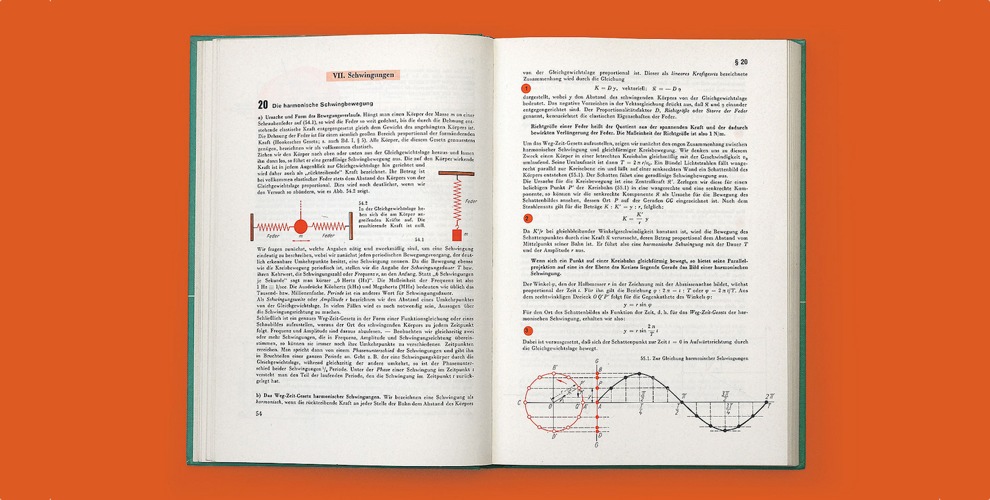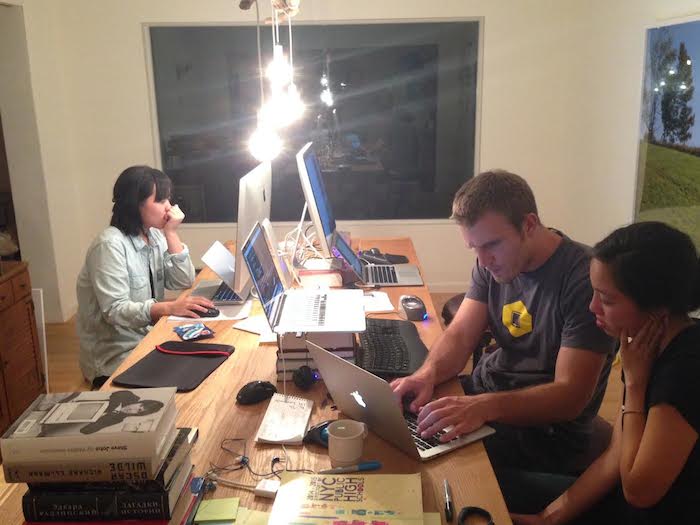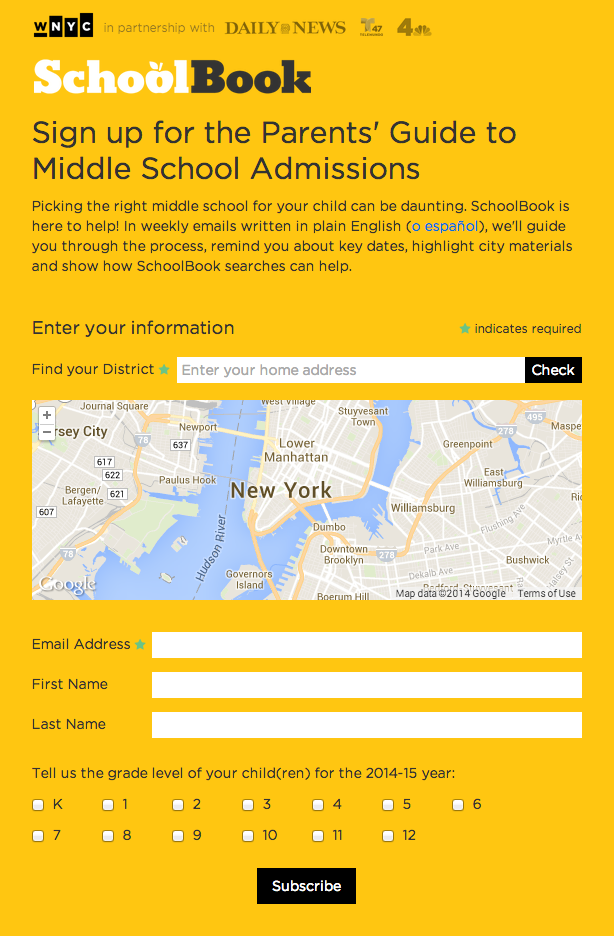
The task fell to senior editor for data news John Keefe and his Data News Team. Keefe is himself a New York City parent, familiar with the confusing and poorly communicated hurdles that need jumping for kids to get through the system — even seemingly straightforward tasks like picking a middle school to attend can be overwhelming.
“My daughter is in middle school this year, and we had to apply for middle schools for her last year,” Keefe says. “I’m a busy parent. My wife and I both work, we’re raising our kids, and all of this information missed us. This is an important process — we’re talking about your kids’ education — and there are things I never knew last year that I’m learning now.”
There are a lot of steps to choosing a middle school for your kids in New York — and to getting them accepted. There are fairs and open houses; you have to keep up to date on which forms and test scores need to be sent where. This process gets underway in October, and WNYC wanted to make sure the new Schoolbook was up and running in time to help parents. In addition, meeting that deadline would help bring a new, information-hungry audience to WNYC’s education coverage.
“You can build it, but will they come? We knew from other traffic that people were checking it here and there,” says Keefe. “We decided that we could build this whole beautiful thing, but it wasn’t going to be seen unless we really developed something around these decision points.”
The Data News team is committed to growing significant audience for Schoolbook, which is why the station is partnering with the New York Daily News, WNBC, and WNJU Telemundo. The site’s email signup and search function will both be embedded as widgets on these partner sites. The search function will also be translated into Spanish and Chinese (emails will be available in Spanish, too) in hopes of serving the widest audience possible.
Wanting to have all of that ready in time for the October open houses meant the Schoolbook team was suddenly under a tight deadline — one that, considering the other pressures of the newsroom, they weren’t sure they could meet. “We figured out that, to pull it off, the only way was to work seven days straight without interruption,” says Keefe. Data News team member Noah Veltman suggested the team take a trip to Bermuda to get the work done. While that was a bit of a reach, there was a grain of sense in it: Startup employees are known for operating on a project-by-project basis, working for long hours back to back to push big projects out — the ethos behind hackathons. Could that environment be productive for a small team inside a larger, legacy public media organization? Keefe decided to find out.
 For a week, four of five WNYC Data News team members — Veltman, Keefe, Louise Ma, and Jenny Ye — sequestered themselves in a house in the town of Callicoon, NY to build the new Schoolbook. (Callicoon is in the Catskills and has a population of of 3,057. Veltman calls it “the Bermuda of the Delaware River Basin.) “For seven days, we worked shoulder to shoulder, and then somebody had to figure out who was making dinner,” Keefe says.
For a week, four of five WNYC Data News team members — Veltman, Keefe, Louise Ma, and Jenny Ye — sequestered themselves in a house in the town of Callicoon, NY to build the new Schoolbook. (Callicoon is in the Catskills and has a population of of 3,057. Veltman calls it “the Bermuda of the Delaware River Basin.) “For seven days, we worked shoulder to shoulder, and then somebody had to figure out who was making dinner,” Keefe says.
 With no meetings and commutes limited to a walk up and down stairs, team members say they were able to accomplish a month’s worth of work on their trip. They also found the new environment more suited for coding in pairs, a setup that will ideally follow them back to Manhattan.
With no meetings and commutes limited to a walk up and down stairs, team members say they were able to accomplish a month’s worth of work on their trip. They also found the new environment more suited for coding in pairs, a setup that will ideally follow them back to Manhattan.
 “Pair programming is a concept where you work on something side-by-side together — looking at one project and solving the code problem together,” says Keefe. “It can seem inefficient, because you have two people working on the same project, but it’s a great way to learn and collaborate.”
“Pair programming is a concept where you work on something side-by-side together — looking at one project and solving the code problem together,” says Keefe. “It can seem inefficient, because you have two people working on the same project, but it’s a great way to learn and collaborate.”
Of course, team retreats might not be affordable for the majority of newsrooms working with small teams, but it’s an interesting model for incorporating news sprints into an otherwise hectic work environment. Keefe says he’s eager to try the retreat model for project management again, possibly on smaller, individual projects, maybe even including some contribution from editorial.
The Schoolbook project, however, focused on design and development. The team had some wireframe sketches and a sense of who they were designing for prepared before leaving New York. “It wasn’t mobile-friendly, and it wasn’t necessarily parent-friendly,” says Keefe. “When you looked at the data, it was really complete, but maybe it was too complete. It had every little data point. It was very transparent, but it was also a little bit overwhelming.”
So they undertook to make the data presentation more straightforward, foregrounding the figures that mattered to parents — attendance, enrollment, class size, racial breakdown — and putting them in context with city averages. The new system, which launches on Monday, will also make it easier to understand where the numbers are coming from, with links to the PDFs of the original forms. The site will also features the ability to search by address, so parents can more easily figure out which schools are near their homes. Here’s a draft of what that will look like:

But making the information more readable wasn’t going far enough, Keefe’s team decided. They wanted to reach parents directly and provide a reminder about responsibilities and deadlines. They thought about using text messages, but ultimately decided the complexity of the school selection process warranted something more in-depth and opted for an email newsletter. When parents sign up, they’ll enter the grades of their kids and their address, which WNYC uses to send them targeted information. Here’s another draft:

“For example, I’m District 6,” says Keefe. “The email I get about the middle school fairs will have the date, time, and address for my middle school fair for my district.” Having access to information about students’ age will also make it possible to ping parents in advance of future deadlines — for example, springtime elementary school selection if they indicated they have a younger child.
To an extent, the Schoolbook project sounds more like work the city government should be doing than a job for a newsroom — but filling the information gap for New York residents is a part of the Data News team’s DNA. “The first map that made it big for us was the hurricane evacuation map, which was built with city data but was better than what the city had,” says Keefe. That kind of service, focusing on solving problems for readers, could be an especially good fit for public media as it moves beyond radio.
“We’re here in the community. We’re listener-supported. If the community feels good about us, maybe that’s good for the station,” Keefe says. “We watch traffic, for sure. But if it has an impact with a longer tail, that’s pretty great.”